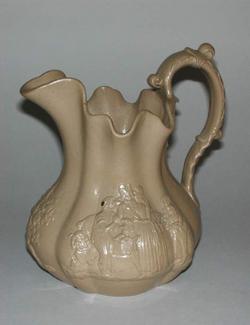Current Location: In storage
Titles
Jug with Gretna Green & Falstaff scenes
Maker(s)
Factory:
Copeland & Garrett
Entities
Categories
Description
Brown, press-moulded and smear-glazed stoneware jug with sprigged decoration.
Press-moulded jug of lobed form with shaped rim, high lip and scroll handle. On one side a sprigged relief of 'The Marriage at Gretna Green'; on the other, 'Falstaff in the Linen Basket'; on the front, below the lip, a hound in front of a tree. The handle has a scrolled thumb piece. The underside is slightly recessed and glazed, within a wavy-edged footrim.
Notes
History note: Unknown before A.H. Palmer
Legal notes
Bequeathed by A H Palmer
Measurements and weight
Height: 18.7 cm
Acquisition and important dates
Method of acquisition: Bequeathed
(1985)
by
Palmer, A. H.
Dating
19th Century, third quarter
William IV
Circa
1833
CE
-
1840
CE
Note
Copeland & Garrett was formed by William Taylor Copeland, with Thomas Garrett, in 1833. The new firm brought in his father’s business and Spode’s Stoke on Trent factory London warehouse and continued in family ownership until 1966. Sprig moulds purchased by Spode from William Turner in 1829 include both ‘Marriage’ and the ‘Falstaff’ scenes similar to those used for this jug, which was produced in different clays, including an off-white version. Meanwhile, Copeland was a Member of Parliament for 25 years and took an interest in the development of provincial art schools, and while this jug was in production, he was Lord Mayor of London (1935-36).
Relief moulded jugs were popular in mid 19th Century homes, where they were used for water, beer, milk and other liquids which might now be kept in bottles, cans or plastic jars.
The smear-glazing makes the most of the way that colour-stained clays show off crisply-moulded ornament, the stoneware is sufficiently durable for everyday use and two piece press-moulding was a relatively inexpensive process. Here the glazing also helps to obscure the join of sprig to body. There are several relief moulded jugs in the Fitzwilliam Collection. The earliest recorded examples of this type date from c.1820 (see C.48-1981) and they were widely available from the early 1930s.
The images on this jug would have been taken from contemporary engravings: versions of both scenes were popular throughout the century. 'Falstaff in the Linen Basket' comes from Shakespeare’s ‘Merry Wives of Windsor’ Act III, scene 3. The scene was perhaps selected for its moral message, since it records Falstaff’s ‘washing’ as a punishment for lascivious behaviour. ‘The Marriage at Gretna Green’ shows a marriage taking place in a blacksmith’s forge. Gretna Green on the Scottish borders, was a popular venue for runaway weddings following the 1754 Marriage Act, which required parental consent for those marrying under the age of 21 in England; in Scotland boys could still legally marry at 14 and girls at 12. A later painting by Edward J Halliday, ‘The Ceremony at Gretna Green’, 1907, in the Compton Verney Collection, clearly comes from the same original source.
People, subjects and objects depicted
Components of the work
Handle To Spout
Width 16.8 cm
Decoration
Materials used in production
Stoneware
Techniques used in production
Press-moulding
: Dark buff, press moulded and smear-glazed stoneware
Smear-glazing
Inscription or legends present
Inscription present: ‘COPELAND & GARRETT’ circular , ‘LATE SPODE’ across the middle, ‘31’ below
- Text: COPELAND & GARRETT/LATE SPODE/31
- Method of creation: Impressed
- Type: Mark
- Text: 12
- Method of creation: Impressed
- Type: Mark
References and bibliographic entries
Identification numbers
Accession number: C.6-1985
Primary reference Number: 75678
Stable URI
Audit data
Created: Saturday 6 August 2011
Updated: Monday 24 February 2025
Last processed: Tuesday 13 May 2025
Associated departments & institutions
Owner or interested party:
The Fitzwilliam Museum
Associated department:
Applied Arts





